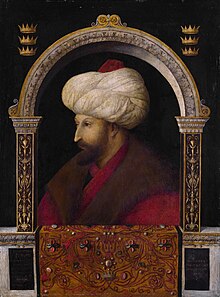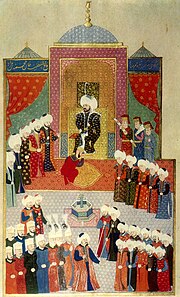The Conqueror Constantinople
| Mehmed the Conqueror | |
|---|---|
 |
Mehmed II (30 March 1432 – 3 May 1481), best known as Mehmed the Conqueror (Turkish: Fatih Sultan Mehmet Han), was an Ottoman sultan who ruled first for a short time from August 1444 to September 1446, and later from February 1451 to May 1481. At the age of 21, he conquered Constantinople (modern-day Istanbul) and brought an end to the Eastern Roman Empire. Mehmed continued his conquests in Anatolia with its reunification and in Southeast Europe as far west as Bosnia. Mehmed is considered a hero in modern-day Turkey and parts of the wider Muslim world. Among other things, Istanbul's Fatih district, Fatih Sultan Mehmet Bridge and Fatih Mosque are named after him.
Mehmed II was born on 30 March 1432, in Edirne, then the capital city of the Ottoman state. His father was Sultan Murad II (1404–51) and his mother Hüma Valide Hatun, born in the town of Devrekani, Kastamonu.
When Mehmed II was eleven years old he was sent to Amasya to govern and thus gain experience, as per the custom of Ottoman rulers before his time. Sultan Murad II also sent a number of teachers for him to study under.This Islamic education had a great impact in molding Mehmet's mindset and reinforcing his Muslim beliefs. He was influenced in his practice of Islamic epistemology by practitioners of science - particularly by his mentor, Molla Gürani - and he followed their approach. The influence of Akshamsaddin in Mehmed's life became predominant from a young age, especially in the imperative of fulfilling his Islamic duty to overthrow the Byzantine empire by conquering Constantinople.
After Murad II made peace with the Karamanids in Anatolia in August 1444, he abdicated the throne to his 12-year-old son Mehmed II.
In Mehmed II's first reign, he defeated the crusade led by János Hunyadi after the Hungarian incursions into his country broke the conditions of the truce Peace of Szeged. Cardinal Julian Cesarini, the representative of the pope, had convinced the king of Hungary that breaking the truce with Muslims was not a betrayal. At this time Mehmed II asked his father Murad II to reclaim the throne, but Murad II refused. Angry at his father, who had long since retired to a contemplative life in southwestern Anatolia, Mehmed II wrote, "If you are the Sultan, come and lead your armies. If I am the Sultan I hereby order you to come and lead my armies." It was only after receiving this letter that Murad II led the Ottoman army and won the Battle of Varna in 1444.
Murad II's return to the throne was forced by Çandarlı Halil Paşa, the grand vizier at the time, who was not fond of Mehmed II's rule, because Mehmed II's influential lala (royal teacher), Akshamseddin, had a rivalry with Çandarlı.
When Mehmed II ascended the throne again in 1451 he devoted himself to strengthening the Ottoman navy and made preparations for the taking of Constantinople. In the narrow Bosphorus Straits, the fortress Anadoluhisarı had been built by his great-grandfather Bayezid I on the Asian side; Mehmed erected an even stronger fortress called Rumelihisarı on the European side, and thus gained complete control of the strait. Having completed his fortresses, Mehmed proceeded to levy a toll on ships passing within reach of their cannon. A Venetian vessel ignoring signals to stop was sunk with a single shot and all the surviving sailors beheaded, except for the captain, who was impaled and mounted as a human scarecrow as a warning to further sailors on the strait.
Abu Ayyub al-Ansari, the companion and standard bearer of Muhammad, had died during the first Siege of Constantinople (674–78). As Mehmed II's army approached Constantinople, Mehmed's sheikh Akshamseddin discovered the tomb of Abu Ayyub al-Ansari. After the conquest, Mehmed built Eyüp Sultan Mosque at the site to emphasize the importance of the conquest to the Islamic world and highlight his role as ghazi.
In 1453 Mehmed commenced the siege of Constantinople with an army between 80,000 and 200,000 troops and a navy of 320 vessels, the bulk of them transports and storeships. The city was surrounded by sea and land; the fleet at the entrance of the Bosphorus stretched from shore to shore in the form of a crescent, to intercept or repel any assistance for Constantinople from the sea. In early April, the Siege of Constantinople began. At first, the city's walls held off the Turks, even though Mehmed's army used the new bombard designed by Orban, a giant cannon similar to the Dardanelles Gun. The harbor of the Golden Horn was blocked by a boom chain and defended by twenty-eight warships.
On 22 April, Mehmed transported his lighter warships overland, around the Genoese colony of Galata, and into the Golden Horn's northern shore; eighty galleys were transported from the Bosphorus after paving a route, little over one mile, with wood. Thus the Byzantines stretched their troops over a longer portion of the walls. About a month later, Constantinople fell, on 29 May, following a fifty-seven-day siege. After this conquest, Mehmed moved the Ottoman capital from Adrianople to Constantinople.
When Sultan Mehmed II stepped into the ruins of the Boukoleon, known to the Ottomans and Persians as the Palace of the Caesars, probably built over a thousand years before by Theodosius II, he uttered the famous lines of Saadi
After the conquest of Constantinople, Mehmed claimed the title "Caesar" of the Roman Empire (Qayser-i Rûm), based on the assertion that Constantinople had been the seat and capital of the Roman Empire since 330 AD, and whoever possessed the Imperial capital was the ruler of the Empire. The contemporary scholar George of Trebizond supported his claim. The claim was recognized by the Eastern Orthodox Church, but not by the Catholic Church and most of, if not all, Western Europe.Gennadius Scholarius, a staunch antagonist of the West because of the Sack of Constantinople committed by the Western Catholics led by Latins and theological controversies between the two Churches, had been enthroned the Ecumenical Patriarch of Constantinople-New Rome with all the ceremonial elements, ethnarch (or milletbashi) status and rights of property that made him the second largest landlord in the said empire by the Sultan himself in 1454, and in turn Gennadius II recognized Mehmed the Conqueror as successor to the throne. Mehmed also had a blood lineage to the Byzantine Imperial family: his predecessor, Sultan Orhan I, had married a Byzantine princess, and Mehmed claimed descent from John Tzelepes Komnenos. He was not the only ruler to claim such a title; Frederick III, emperor of the Holy Roman Empire in Western Europe, traced his lineage from Charlemagne, who had taken the title of Roman Emperor when he was crowned by Pope Leo III in 800 – although never recognized as such by the Byzantine Empire.
Byzantine Emperor Constantine XI died without producing an heir, and had Constantinople not fallen to the Ottomans he likely would have been succeeded by the sons of his deceased elder brother. Those children were taken into the palace service of Mehmed after the fall of Constantinople. The oldest boy, renamed Has Murad, became a personal favorite of Mehmed and served as Beylerbey (Governor-General) of the Balkans. The younger son, renamed Mesih Pasha, became Admiral of the Ottoman fleet and Sanjak-bey (Governor) of the Province of Gallipoli. He eventually served twice as Grand Vizier under Mehmed's son, Bayezid II.
After the Fall of Constantinople, Mehmed would also go on to conquer the Despotate of Morea in the Peloponnese in 1460, and the Empire of Trebizond in northeastern Anatolia in 1461. The last two vestiges of Byzantine rule were thus absorbed by the Ottoman Empire. The conquest of Constantinople bestowed immense glory and prestige on the country. There is some historical evidence that, 10 years after the conquest of Constantinople, Mehmed II visited the site of Troy and boasted that he had avenged the Trojans by conquering the Greeks (Byzantines).
The news of Mehmed's death caused great rejoicing in Europe; church bells were rung and celebrations held. The news was proclaimed in Venice thus: "La Grande Aquila è morta!" ('The Great Eagle is dead!')



Komentar
Posting Komentar